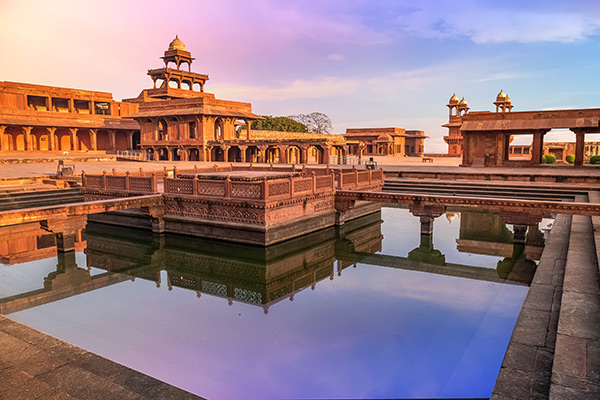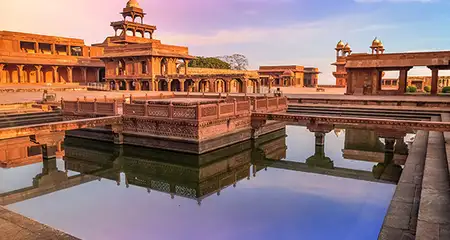Fatehpur Sikri near Agra is a fortified city built to serve as the capital of the Mughal Empire during the late 16th century. However, the city served this purpose only for 14 years and was abandoned completely by the turn of the 17th century. This historical city is now a UNESCO World Heritage Site and one of the prime tourist attractions in Agra. If you are fascinated by the Mughal architecture or have a keen interest in Indian history, keep aside a day in your itinerary while booking your hotels in Agra to explore this attraction.
Looking for more details about this top historical place near Agra? This blog brings to you the history, architecture, timings, entry fee, and other interesting facts and things to see in Fatehpur Sikri.
Fatehpur Sikri Information:
| Location | Agra District |
| Distance from Major Cities | Agra (36 km); Jaipur (205 km); Delhi (225 km) |
| Timings | 6:00 am to 6:30 pm; closed on Fridays |
| Entry Fee | ₹ 40 for Indians; ₹ 550 for foreigners; free entry for children below 15 years |
| Status | UNESCO World Heritage Site |
| Date of Establishment | 1571 |
| Commissioned by | Emperor Akbar |
| Material Used | Red sandstone |
| Architectural Style | A blend of Mughal and Indian styles |
Fatehpur Sikri: History
Fatehpur Sikri is considered to be the crowning architectural legacy of Mughal Emperor Akbar who founded it in 1571. The city derives part of its name from a village called Sikri, which existed on the very spot where it was constructed. History has it that Akbar had visited this village and consulted a Sufi saint by the name Shaikh Salim Chishti. The saint foretold the birth of his heir and when the prophecy was fulfilled, Akbar began constructing his capital in the village.
From 1571 to 1585, Fatehpur Sikri served as the capital of the Mughal Empire. In 1573, when Akbar returned victorious from his Gujarat campaign, the city was named Fatehpur Sikri or the City of Victory to commemorate the win. When he proceeded towards Punjab in 1585 to fight for his next military campaign, he abandoned the city. It is believed that the city was abandoned due to two primary reasons – the lack of water and the unrest in the north-western part of the country. Akbar later shifted the capital of his empire to Lahore and then to Agra, and by 1610, Fatehpur Sikri became a fully abandoned city.
Much later, when the colonial rulers occupied Agra in 1803, they established an administrative center here, which remained functional until 1850. The monuments at Fatehpur Sikri were repaired in 1815 under the orders of the Marquess of Hastings.
Fatehpur Sikri Architecture
Fatehpur Sikri is a fortified city that is enveloped by 6-km long defensive walls with several entryways on three sides while fourth side borders on an artificial lake. The city features the Indo-Islamic architectural style and is constructed using red sandstone.
A number of palaces, mosques, monuments, public buildings, and other structures adorn the city, each of which displays exemplary architectural beauty. Within this fortified city, Akbar also built three palaces for each of his three favorite wives. There are also eight gates that serve as entryways to the city, including the Delhi Gate, the Agra Gate, the Lal Gate, the Gwalior Gate, and the Ajmeri Gate, among others.
Among the most famous structures of the city is the Jama Masjid, one of the largest mosques in India which is functional even today. The intricate architecture of structures like the Buland Darwaza, the Tomb of Salim Chisti, and the Panch Mahal attracts tourists from all over the country and beyond. It is one of the famous places to visit in Agra.
Fatehpur Sikri: Today
Today, Fatehpur Sikri is one of the key historical monuments belonging to the Mughal era and a top tourist attraction in Agra. The abandoned city attained the status of UNESCO World Heritage Site in 1986 due to its architectural beauty and historical relevance. The site and the monuments and structures in and around it are protected and maintained by the Archaeological Survey of India. Needless to say, a visit to Fatehpur Sikri is counted among the top things to do in Agra.
Things to See in the Fatehpur Sikri Complex
Located not far away from Agra, Fatehpur Sikri encloses various attractions within its walled premises. Some of the major things to see in Fatehpur Sikri include:
- Buland Darwaza or the Gate of Victory, the main gateway to the palace at Fatehpur Sikri
- Jama Masjid, a congregational mosque and one of the first monuments built in the city
- Tomb of Salim Chishti, the burial spot of the Sufi saint Sheikh Salim Chishti who predicted the birth of an heir to Akbar
- Diwan-i-Aam or Hall of Public Audience, the place where the Emperor used to meet the general public
- Diwan-i-Khas or Hall of Private Audience, where the Emperor conducted discussions with representatives of various religions and faiths
- Ibadat Khana, a debating house
- Anup Talao, an ornamental water body where the musical legend Tansen used to perform
- Panch Mahal, a five-story palace
- Akbar’s residence
- Hujra-i-Anup Talao, believed to be the residence of Akbar’s Muslim wife
- Jodhabai’s Palace or Mariam-uz-Zamani’s Palace, the residence of Akbar’s Rajput wife, Jodhabai
- Naubat Khana or Naqqar Khana, a drum house from where drums were used to announce the Emperor’s arrival
- Birbal’s House, house of the favorite minister of Akbar
- Hiran Minar or Elephant Tower
- Karkhana or the royal workshop
- Khazana or Treasury
- Hammam or Turkish Baths
- Daftar Khana, the record room of Akbar
- Pachisi Court, a square designed like a board game where Akbar used to play the game of Pachisi (similar to ludo) using real people as playing pieces
Lesser Known Facts about Fatehpur Sikri
- Fatehpur Sikri is the first planned city in India by the Mughals.
- According to Ralph Fitch, a 16th-century English traveler, Fatehpur Sikri was much larger and more populous than London at that time.
- The structure and layout of Fatehpur Sikri influenced the planning and construction of Shahjahanabad or Old Delhi.
- Jahangir, Akbar’s son, stayed at Fatehpur Sikri for three months in 1619, when the region was reeling under the impact of bubonic plague.
- After abandoning the city, Akbar visited it only once before his death.
Fatehpur Sikri is a splendid reminder of India’s rich cultural and architectural heritage. If you are interested in exploring more such historical places, you can chalk out a 5-day Golden Triangle tour covering Delhi, Agra, Fatehpur Sikri, and Jaipur. So, why wait anymore? Go ahead and start planning your trip to Fatehpur Sikri and its surrounding attractions.




























